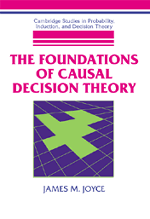Book contents
- Frontmatter
- Contents
- Preface
- Introduction: A Chance to Reconsider
- Chapter 1 Instrumental Rationality as Expected Utility Maximization
- Chapter 2 Decision Problems
- Chapter 3 Savage's Theory
- Chapter 4 Evidential Decision Theory
- Chapter 5 Causal Decision Theory
- Chapter 6 A General Theory of Conditional Beliefs
- Chapter 7 A Representation Theorem for Causal Decision Theory
- Chapter 8 Where Things Stand
- References
- Index
Chapter 1 - Instrumental Rationality as Expected Utility Maximization
Published online by Cambridge University Press: 25 July 2009
- Frontmatter
- Contents
- Preface
- Introduction: A Chance to Reconsider
- Chapter 1 Instrumental Rationality as Expected Utility Maximization
- Chapter 2 Decision Problems
- Chapter 3 Savage's Theory
- Chapter 4 Evidential Decision Theory
- Chapter 5 Causal Decision Theory
- Chapter 6 A General Theory of Conditional Beliefs
- Chapter 7 A Representation Theorem for Causal Decision Theory
- Chapter 8 Where Things Stand
- References
- Index
Summary
This chapter provides a brief quasi-historical introduction to expected utility theory, the most widely defended version of normative decision theory. The overarching goal of normative decision theory is to establish a general standard of rationality for the sort of instrumental (or “practical”) reasoning that people employ when trying to choose means appropriate for achieving ends they desire. Expected utility theory champions subjective expected utility maximization as the hallmark of rationality in this means-ends sense.
We will examine the theory in the setting where it works best by applying it to the case of professional gamblers playing games of chance inside casinos. In this highly idealized situation, the end is always the maximization of one's own fortune, and the means is the ability to buy and sell wagers that offer monetary payoffs at known odds. Later chapters will consider more general contexts. Since the material here is presented in an elementary (and somewhat pedantic) way, those who already understand the concept of expected utility maximization and the rudiments of decision theory are encouraged to proceed directly to Chapter 2.
PASCAL AND THE “PROBLEM OF THE POINTS”
The Port Royal Logic of 1662 contains the first general statement of the central dogma of contemporary decision theory:
In order to decide what we ought to do to obtain some good or avoid some harm, it is necessary to consider not only the good or harm in itself, but also the probability that it will or will not occur; and to view geometrically the proportion that all these things have when taken together.
Information
- Type
- Chapter
- Information
- The Foundations of Causal Decision Theory , pp. 9 - 47Publisher: Cambridge University PressPrint publication year: 1999
